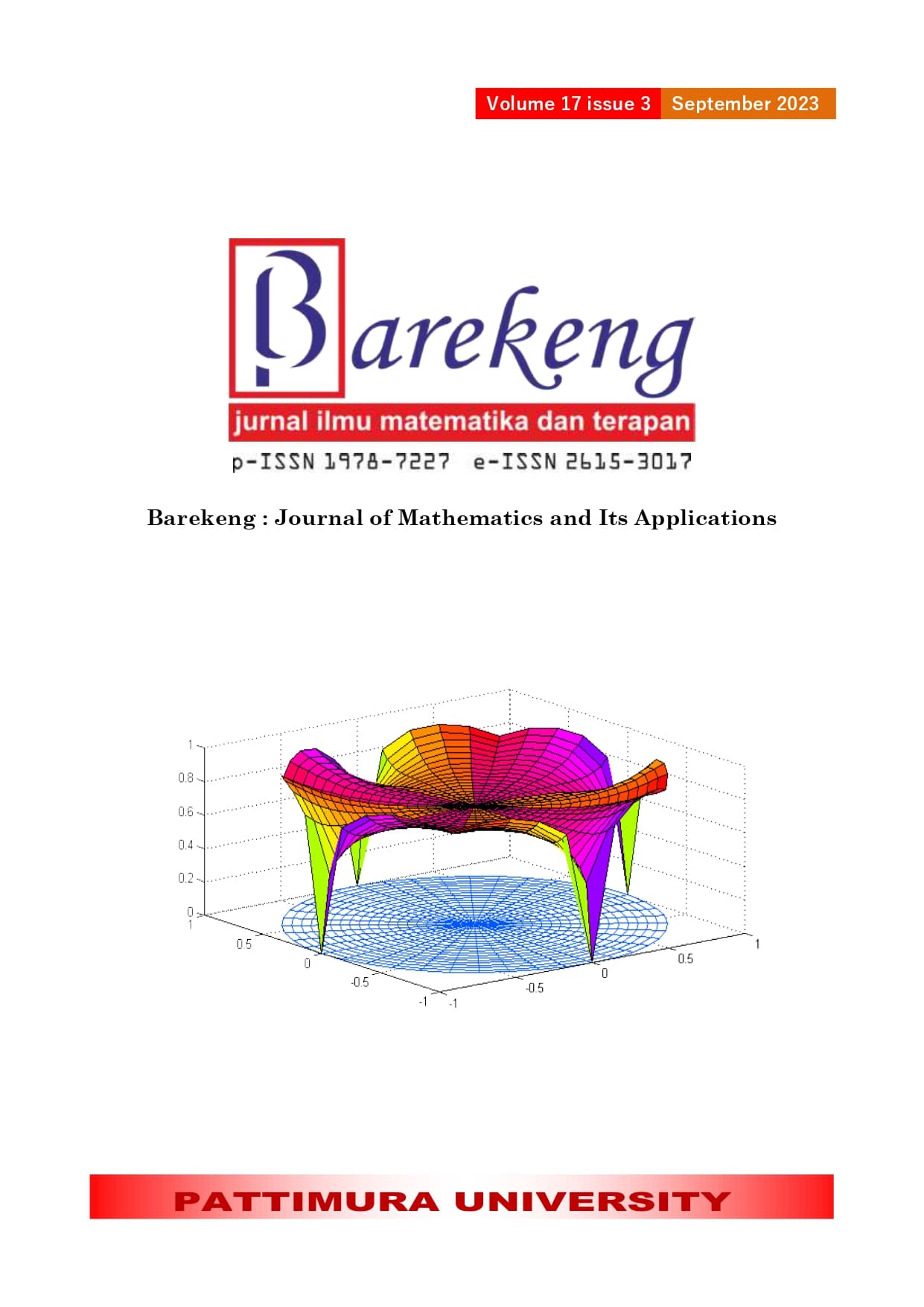COMPARISON OF RANDOM FOREST AND NAÏVE BAYES CLASSIFIER METHODS IN SENTIMENT ANALYSIS ON CLIMATE CHANGE ISSUE
Abstract
The last decade was recorded as a decade with a bad record on the issue of disasters in the world due to climate change. Measuring public opinion is one of the steps to mitigate the impact of climate change. Twitter is a popular social media for channeling opinions. Twitter provides a great source of data for understanding public opinion and the perceived risk of an issue. In recent decades, when discussing climate change, there are those who agree and those who oppose it. Sentiment analysis is a branch of learning in the realm of text mining that is used as a solution to see opinions on a problem, one of which is climate change. In this study, we will try to analyze opinions on climate change issues using the Random Forest and Naïve Bayes classifier methods. Data were obtained from Twitter for the period January 2022-June 2022. The training data used in this research is 80%:20%. There are slightly more positive statements than negative ones. The results obtained with the Naïve Bayes classifier method are an accuracy of 76.25%, an F-1 score of 78%, and a recall of 80%. While the results of the random forest method are 70.6% accuracy, 69% F-1 score, and 63% recall. The Nive Bayes method is better than the Random Forest method for classifying climate change opinions with an accuracy of 76.25%.
Downloads
References
Y. Chen, J. Li, and A. Chen, “Does high risk mean high loss: Evidence from flood disaster in southern China,” Science of The Total Environment, vol. 785, p. 147127, 2021, doi: https://doi.org/10.1016/j.scitotenv.2021.147127.
B. A. Revich, “Toward the assessment of the Russian population mortality risk factors and the feasibility of their reduction: Comments on the World Bank Report ‘dying Too Young,’” Stud Russ Econ Dev, vol. 17, no. 6, pp. 643–654, Dec. 2006, doi: 10.1134/S1075700706060104.
S. Solomon, Climate change 2007 : the physical science basis : contribution of Working Group I to the Fourth Assessment Report of the Intergovernmental Panel on Climate Change. Cambridge University Press, 2007.
Y. Suryadi, D. N. Sugianto, and Hadiyanto, “Climate Change in Indonesia (Case Study: Medan, Palembang, Semarang),” E3S Web of Conferences, vol. 31, pp. 3–8, 2018, doi: 10.1051/e3sconf/20183109017.
Supari, F. Tangang, L. Juneng, and E. Aldrian, “Observed changes in extreme temperature and precipitation over Indonesia,” International Journal of Climatology, vol. 37, no. 4, pp. 1979–1997, 2017, doi: https://doi.org/10.1002/joc.4829.
B. Dahal, S. A. P. Kumar, and Z. Li, “Topic modeling and sentiment analysis of global climate change tweets,” Soc Netw Anal Min, vol. 9, no. 1, p. 24, 2019, doi: 10.1007/s13278-019-0568-8.
B. Zhang Lei and Liu, “Sentiment Analysis and Opinion Mining,” in Encyclopedia of Machine Learning and Data Mining, G. I. Sammut Claude and Webb, Ed., Boston, MA: Springer US, 2017, pp. 1152–1161. doi: 10.1007/978-1-4899-7687-1_907.
Bahrawi, “SENTIMENT ANALYSIS USING RANDOM FOREST ALGORITHM-ONLINE SOCIAL MEDIA BASED.”
P. Liu, H. han Zhao, J. yu Teng, Y. yan Yang, Y. feng Liu, and Z. wei Zhu, “Parallel naive Bayes algorithm for large-scale Chinese text classification based on spark,” J Cent South Univ, vol. 26, no. 1, pp. 1–12, Jan. 2019, doi: 10.1007/s11771-019-3978-x.
H. Annur, “KLASIFIKASI MASYARAKAT MISKIN MENGGUNAKAN METODE NAÏVE BAYES,” ILKOM Jurnal Ilmiah, vol. 10, no. 2, pp. 160–165, 2018.
C. J. Hinde, R. Stone, D. Xhemali, C. J. Hinde, and R. G. Stone, “Naïve Bayes vs. Decision Trees vs. Neural Networks in the Classification of Training Web Pages,” IJCSI International Journal of Computer Science Issues, vol. 4, no. 1, 2009, [Online]. Available: https://hdl.handle.net/2134/5394.
A. Primajaya and B. N. Sari, “Random Forest Algorithm for Prediction of Precipitation,” Indonesian Journal of Artificial Intelligence and Data Mining (IJAIDM), vol. 1, no. 1, pp. 27–31, 2018.
R. Supriyadi, W. Gata, N. Maulidah, A. Fauzi, I. Komputer, and S. Nusa Mandiri Jalan Margonda Raya No, “Penerapan Algoritma Random Forest Untuk Menentukan Kualitas Anggur Merah,” JURNAL ILMIAH EKONOMI DAN BISNIS, vol. 13, no. 2, pp. 67–75, 2020, [Online]. Available: http://journal.stekom.ac.id/index.php/E-Bisnis■page67
M. Lydiri, Y. el Habouz, and H. Zougagh, “Sentiment Analysis Decision System for Tracking Climate Change Opinion in Twitter,” in Business Intelligence, M. Fakir, M. Baslam, and R. el Ayachi, Eds., Cham: Springer International Publishing, 2022, pp. 188–196.
B. Dahal, S. A. P. Kumar, and Z. Li, “Topic modeling and sentiment analysis of global climate change tweets,” Soc Netw Anal Min, vol. 9, no. 1, Dec. 2019, doi: 10.1007/s13278-019-0568-8.
A. Sabika, “SENTIRESEARCH: LEXICON-BASED WEB APPLICATION FOR INDONESIAN SENTIMENT ANALYSIS,” 2020.
P. M. Dikky and A. Indriani, “IMPLEMENTASI TEXT MINING DALAM KLASIFIKASI BUKU DENGAN METODE NAÏVE BAYES CLASSIFIER STUDI KASUS PADA PERPUSTAKAAN STMIK PPKIA TARAKANITA RAHMAWATI,” in Seminar Nasional Inovasi dan Tren, 2014, pp. 243–247.
V. F. Rodriguez-Galiano, B. Ghimire, J. Rogan, M. Chica-Olmo, and J. P. Rigol-Sanchez, “An assessment of the effectiveness of a random forest classifier for land-cover classification,” ISPRS Journal of Photogrammetry and Remote Sensing, vol. 67, pp. 93–104, 2012, doi: https://doi.org/10.1016/j.isprsjprs.2011.11.002.
Copyright (c) 2023 Fatkhurokhman Fauzi, Wiwik Setiayani, Tiani Wahyu Utami, Eko Yulianto, Iis Widya Harmoko

This work is licensed under a Creative Commons Attribution-ShareAlike 4.0 International License.
Authors who publish with this Journal agree to the following terms:
- Author retain copyright and grant the journal right of first publication with the work simultaneously licensed under a creative commons attribution license that allow others to share the work within an acknowledgement of the work’s authorship and initial publication of this journal.
- Authors are able to enter into separate, additional contractual arrangement for the non-exclusive distribution of the journal’s published version of the work (e.g. acknowledgement of its initial publication in this journal).
- Authors are permitted and encouraged to post their work online (e.g. in institutional repositories or on their websites) prior to and during the submission process, as it can lead to productive exchanges, as well as earlier and greater citation of published works.






1.gif)



